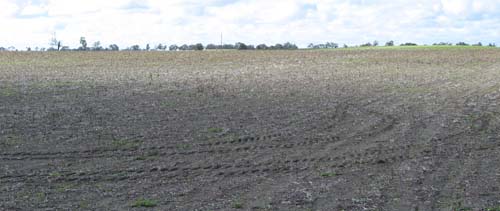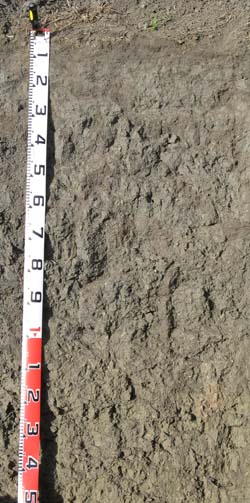LWA18
Location: Minyip
Australian Soil Classification: Epicalcareous-Endohypersodic, Epipedal, Grey VERTOSOL
General Landscape Description: Undulating plain.
Site Description: Demonstration site. Cereal stubble under no-till management.

LWA18 Landscape - soil site in foreground.
Soil Profile Morphology:
| Surface Soil |  LWA18 profile | ||
| A1 | 0-12 cm | Very Dark Grey (10YR3/1); light clay; firm surface condition; very weak consistence moderately moist; moderate medium polyhedral, parting to moderate very fine granular structure; slightly calcareous; few roots; pH 8.1; abrupt change to: | |
| Subsoil | |||
| B1 | 12-28 cm | Dark Grey (2.5Y4/1); light-medium clay; very weak consistence moderately moist; moderate fine platy structure, parting to moderate very fine granular structure; distinct slickensides common; very few (<2%) medium calcareous concretions; few roots; pH 8.2; abrupt change to: | |
| B21 | 28-70 cm | Dark Grey (5Y4/1) with very dark grey (2.5Y3/1) mottles; medium-heavy clay; moderate coarse (20-50 mm) prismatic, parting to strong medium angular blocky structure; strong consistence dry; few (2-10%) coarse calcareous concretions; slighly calcareous; distinct slickensides common; roots common; pH 8.5; diffuse change to: | |
| B22 | 70-93 cm | Grey (2.5Y5/1) with very dark grey (10YR3/1) mottles; medium-heavy clay; moderate coarse (50-100mm) prismatic, parting to moderate coarse (20-50 mm) prismatic and moderate medium angular blocky structure; strong consistence dry; few (2-10%) medium and coarse calcareous concretions; slightly calcareous; few roots; prominent slickensides common (100 mm long); pH 8.9; gradual change to: | |
| B23 | 93-120 cm | Grey (5Y5/1) with few (10%) dark grey (2.5Y4/1) mottles; heavy clay; strong very coarse (100-200 mm) prismatic, parting to strong coarse (20-50 mm) angular blocky structure; very strong consistence dry; very few (<2%) coarse calcareous concretions; slightly calcareous; prominent slickensides common (100 mm long); pH 9.2; gradual change to: | |
| B24 | 120-150+ cm | Greyish brown (2.5Y5/2) with brownish yellow (10YR6/8) mottles; weak to moderate coarse (20-50mm) prismatic, parting to moderate medium angular blocky structure; strong consistence dry; very few coarse calcareous concretions with very few (<2%) medium manganiferous nodules; slightly calcareous; prominant slickensides common up to 75 mm long; pH 9.3. | |
Soil Profile Characteristics:
pH | Salinity Rating | |||
Surface (A1 horizon) | Moderately Alkaline | Low | Non-Sodic | None2 |
Subsoil (B21 horizon) | Moderately Alkaline | Low | Sodic | None1 |
Deeper subsoil (at 95-120 cm) | Very Strongly Alkaline | Low-Moderate | Strongly Sodic | Moderate3 |

| The pH in the surface and upper subsoil is moderately alkaline. The deeper subsoil is very strongly alkaline. |
| The surface is non sodic. The subsoil is sodic, becoming strongly sodic with depth. | The clay content is high throughout the soil profile. | Boron levels increase in the deeper subsoil. |
Chemical and Physical Analysis:
Horizon | Horizon Depth (cm) | pH (water) | pH (CaCl2) | EC dS/m | NaCl % | Exchangeable Cations | |||
Ca | Mg | K | Na | ||||||
meq/100g | |||||||||
A1 | 0-12 | 8.1 | 7.7 | 0.21 | 38 | 5.3 | 2.9 | 0.66 | |
B1 | 12-28 | 8.2 | 7.8 | 0.47 | <0.02 | 34 | 9.8 | 2.2 | 2.6 |
B21 | 28-70 | 8.5 | 7.9 | 0.47 | 0.24 | 27 | 11 | 1.7 | 3.7 |
B22 | 70-93 | 8.9 | 8.1 | 0.49 | 0.042 | 21 | 13 | 1.9 | 7.1 |
B23 | 93-120 | 9.2 | 8.4 | 0.74 | 0.09 | 15 | 15 | 2.1 | 12 |
B24 | 120-150 | 9.3 | 8.6 | 0.99 | 0.13 | 12 | 16 | 2.3 | 16 |
Horizon | Horizon Depth (cm) | Boron mg/kg | Organic Carbon % | Total Nitrogen % | Field Capacity pF2.5 | Wilting Point pF4.2 | Coarse Sand (0.2-2.0 mm) | Fine Sand (0.02-0.2 mm) | Silt (0.002-0.02 mm) | Clay (<0.002 mm) |
A1 | 0-12 | 2 | 1.2 | 0.12 | 42 | 21.9 | 14 | 16 | 16 | 45 |
B1 | 12-28 | 2.2 | 0.45 | 0.051 | 49.2 | 25.7 | 11 | 10 | 11 | 62 |
B21 | 28-70 | 2.4 | 49.5 | 27.1 | 11 | 10 | 11 | 62 | ||
B22 | 70-93 | 3.5 | 53.2 | 26.9 | 11 | 10 | 10 | 62 | ||
B23 | 93-120 | 9 | 59.5 | 29 | ||||||
B24 | 120-150 | 19 | 61.4 | 30.4 |
Profile Described By: Melissa Cann (May 2007).


